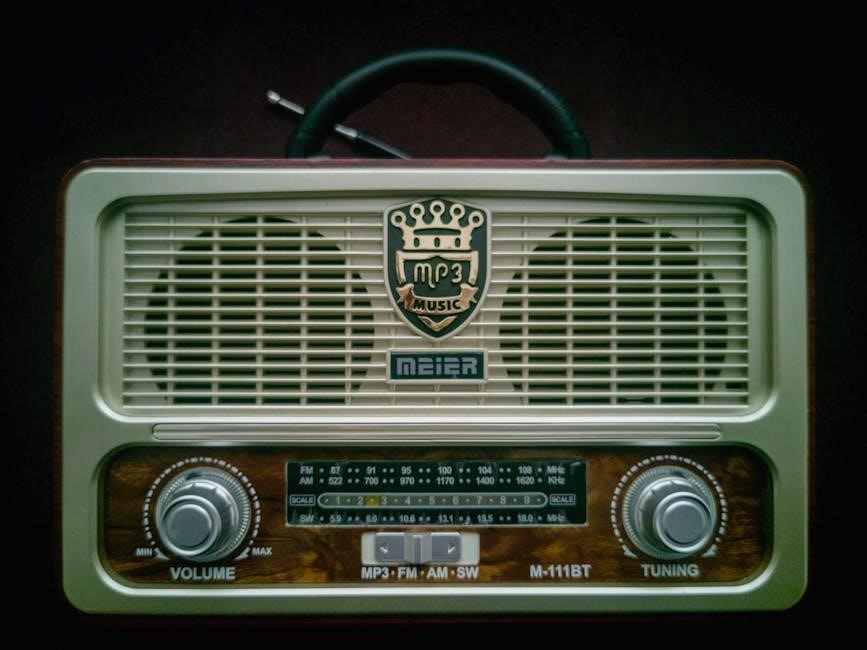sandisk manuals for mp3 players

SanDisk MP3 player manuals provide essential guidance for optimal device use. Covering models like Sansa Clip and Clip Sport Plus, they offer setup, operation, and troubleshooting tips. Download them from official SanDisk support or trusted sources for free.
1.1 Importance of User Manuals for MP3 Players
User manuals are essential for understanding and optimizing the use of SanDisk MP3 players. They provide detailed guidance on device operation, safety precautions, and troubleshooting. Manuals ensure users can navigate features like playlists, equalizers, and media transfer efficiently. They also highlight critical safety tips, such as proper battery care and hearing protection. By following the manual, users can avoid common issues like file compatibility problems or device recognition errors. Additionally, manuals often include instructions for firmware updates and advanced features, helping users maximize their device’s potential. Referencing the manual ensures a smooth and enjoyable experience with your SanDisk MP3 player.
1.2 Overview of SanDisk MP3 Player Models
SanDisk offers a variety of MP3 player models, each designed for unique user preferences; Popular models include the Sansa Clip, Clip Sport Plus, and Sansa e200R Rhapsody. These devices are known for their portability, durability, and user-friendly interfaces. The Sansa Clip series is compact and ideal for everyday use, while the Clip Sport Plus is tailored for fitness enthusiasts; The Sansa e200R Rhapsody model supports advanced features like FM radio and voice recording. Each model offers distinct storage capacities and multimedia capabilities, ensuring a wide range of options for music lovers. Manuals for these models provide detailed insights into their specific functions and settings, helping users maximize their device’s performance.
1.3 Where to Find SanDisk MP3 Player Manuals
SanDisk MP3 player manuals are readily available online through various sources. The official SanDisk website provides direct links to download user guides for specific models like the Sansa Clip and Clip Sport Plus. Additionally, websites such as ManualsLib and Manuals.ca offer a wide range of SanDisk manuals for free download. Users can search by model name or browse through categorized lists to find the appropriate manual. These resources often include detailed instructions for setup, operation, and troubleshooting, ensuring users can maximize their device’s functionality. Accessing these manuals is straightforward, making it easy for users to resolve issues or learn new features.

Safety Guidelines for Using SanDisk MP3 Players
Always follow safety guidelines to ensure safe usage of your SanDisk MP3 player. Avoid using headphones while driving, keep volume levels moderate to protect hearing, and handle the device with care to prevent damage.
2.1 General Safety Precautions
Always read the safety instructions carefully before using your SanDisk MP3 player. Avoid using headphones while driving, cycling, or operating machinery to ensure your safety. Handle the device gently to prevent damage and avoid exposing it to extreme temperatures or water. Use only original or recommended accessories to maintain performance and safety. Keep the player away from children and ensure proper ventilation to prevent overheating. Regularly check the battery and charging cable for damage. Follow all local regulations and manufacturer guidelines for safe and optimal use of your SanDisk MP3 player.
2.2 Hearing Safety Instructions
SanDisk MP3 player manuals emphasize the importance of hearing safety. Listen to your device at a volume where you can still hear your surroundings. Avoid prolonged exposure to high decibel levels, as sounds above 80 decibels may cause hearing damage over time. Take regular breaks from listening to give your ears time to rest. Never use headphones while driving, cycling, or operating machinery. Keep the volume low enough to allow conversation without shouting. Protect your hearing by following these guidelines to enjoy your music safely and responsibly with your SanDisk MP3 player.
2.3 Proper Handling and Storage
Proper handling and storage are crucial for maintaining your SanDisk MP3 player’s performance and longevity. Avoid exposing the device to extreme temperatures, moisture, or direct sunlight, as these can damage internal components. Clean the screen regularly with a soft cloth to prevent scratches. Store the player in a protective case when not in use to avoid physical damage. Keep the device away from magnetic fields and chemicals. For long-term storage, ensure the battery is partially charged to prevent deep discharge. Follow these guidelines to ensure your SanDisk MP3 player remains in optimal condition and functions reliably for years to come.

Basic Operations of SanDisk MP3 Players
SanDisk MP3 players feature intuitive controls. Use the Power button to turn on/off and select options. Navigate via the touch-sensitive pad and easily access core functions like Music, Videos, and Settings through the home menu.
3.1 Turning the Device On/Off
To turn on your SanDisk MP3 player, press and hold the Power button for 2 seconds until the screen lights up. The device will initialize and display the home menu. To turn it off, press and hold the same button for 2 seconds until the screen goes dark. The Power button is centrally located and serves as the primary control for basic operations. Ensure the battery is charged before use, as a low battery may not power the device on. The startup process may include a brief boot screen and initialization of core functions. Properly turning the device off helps conserve battery life.
3.2 Navigating the User Interface
Navigating the SanDisk MP3 player’s user interface is straightforward. Use the touch-sensitive pad to scroll through menus by swiping left or right. Tap the pad to select options or press and hold for additional features. The home screen displays core functions like Music, Videos, and Radio. Swipe up or down to explore submenus and adjust settings. The interface is intuitive, with visual cues and icons guiding you through operations. For example, swiping left or right navigates through songs or folders, while tapping the center selects an item. This design ensures easy access to all features, making the device user-friendly for both beginners and experienced users.
3.3 Basic Playback Controls
The SanDisk MP3 player features intuitive controls for seamless media playback. Use the Power button to turn the device on or off and to select menu options. Adjust the volume using the dedicated buttons, ensuring optimal audio levels. Playback controls include Play/Pause, Skip Forward, and Skip Backward, allowing easy navigation through your music library. The touch-sensitive interface enables quick access to shuffle and repeat modes, enhancing your listening experience. These straightforward controls make it easy to manage your media playback, providing a user-friendly experience for enjoying your favorite songs and podcasts on the go.

Transferring Media to SanDisk MP3 Players
Transfer music, photos, and videos to your SanDisk MP3 player via USB in MSC or MTP mode. Use Windows Media Player or drag-and-drop files for easy synchronization.
4.1 Connecting the Device to a Computer
To connect your SanDisk MP3 player to a computer, use the provided micro-USB cable. Plug the smaller end into the player’s USB port and the larger end into the computer’s USB slot. Ensure the connection is secure for proper recognition. The device will appear in your computer’s file explorer, allowing drag-and-drop file transfers. For Windows users, Windows Media Player can synchronize media in MTP mode, while MSC mode enables direct file management. If the computer doesn’t recognize the player, try a different USB port or restart the device. Charging may also be done via an AC adapter, though it’s not included.
4.2 Using MSC Mode for File Transfer
MSC (Mass Storage Class) mode allows your SanDisk MP3 player to function like a removable storage device. To use MSC mode, connect the player to your computer via USB. The device will appear in your file explorer as a removable drive. You can then drag and drop music, photos, and videos directly into the appropriate folders. This mode bypasses media management software, offering a straightforward file transfer experience. Ensure the player is set to MSC mode in the device settings before connecting. This method is ideal for users who prefer manual file management without relying on additional software.
4.3 Using MTP Mode for Media Transfer
MTP (Media Transfer Protocol) mode enables seamless media synchronization with your computer. Connect your SanDisk MP3 player to a PC, and it will automatically recognize the device. Using Windows Media Player, you can sync music, videos, and playlists. In MTP mode, the player integrates with media management software, allowing for organized file transfer. This mode is ideal for users who prefer synchronized libraries and playlists. Ensure your computer has Windows Media Player installed for optimal functionality. MTP mode streamlines media transfer, making it easy to manage your digital content efficiently.
4.4 Creating and Transferring Playlists
Creating and transferring playlists to your SanDisk MP3 player is a straightforward process. Use Windows Media Player to organize your music library and create playlists. Name your playlist, add songs by dragging and dropping, and save it. Connect your device to the computer, ensure it is in MTP mode, and sync the playlist. The player will automatically organize the playlists for easy access. This feature allows you to enjoy your favorite music seamlessly on the go. Ensure your computer recognizes the device before transferring to avoid any issues. Playlists enhance your listening experience by letting you curate and manage your music efficiently.
4.5 Loading Photos and Videos
Loading photos and videos onto your SanDisk MP3 player is simple. Connect the device to your computer and use the Sansa Media Converter to transfer files. This tool automatically resizes photos and optimizes videos for the player’s screen. Select the files you want to transfer, and the converter will handle formatting and resizing. Organize your media into folders for easy navigation on the device. Once transferred, access your photos and videos through the player’s interface. This feature enhances your multimedia experience, allowing you to enjoy visual content on the go. Ensure your device is in the correct mode (MSC or MTP) for seamless file transfer. This makes sharing and viewing your media effortless and convenient.

Customizing Your SanDisk MP3 Player
Customize your SanDisk MP3 player with settings like equalizer, display options, and lock functions. Adjust preferences to enhance audio quality and personalize your user experience effortlessly.
5.1 Adjusting Settings for Optimal Use
Adjusting settings on your SanDisk MP3 player ensures a personalized and efficient experience. Navigate to the settings menu to customize options like brightness, volume limits, and USB mode. Enable MSC or MTP mode for file transfers, depending on your preferences. Adjust the equalizer to enhance audio quality and tailor sound to your liking. Set time and date formats, and explore display settings for better visibility. Use the lock function to prevent accidental changes. Regularly update firmware for improved performance and new features. These adjustments ensure your device is optimized for your specific needs, enhancing both functionality and user satisfaction.
5.2 Equalizer Settings for Enhanced Audio
The equalizer settings on SanDisk MP3 players allow users to customize their audio experience. With options like rock, jazz, and bass boost, you can tailor sound to your preferences. Preset modes enhance specific frequencies, while custom settings let you adjust treble, bass, and midrange levels. Experiment with these options to achieve the perfect balance for your music. For optimal results, pair equalizer settings with high-quality headphones. This feature ensures a richer and more immersive listening experience, making your SanDisk MP3 player a versatile tool for audiophiles and casual listeners alike. Regularly explore these settings to discover new sound profiles and enjoy your music to the fullest.
5.3 Display Customization Options
SanDisk MP3 players offer display customization options to enhance user experience. Adjust brightness and contrast for optimal visibility in various lighting conditions. Themes and color schemes allow personalization, while screen savers conserve battery life. Users can enable or disable auto-lock features to prevent accidental button presses. Some models support orientation adjustments for better viewing angles. Access these settings through the device’s system menu to tailor the display to your preferences. Customization options vary by model but generally include features like font size adjustment and wallpaper selection. Regularly update firmware to access new display features and improvements. This ensures your SanDisk MP3 player remains user-friendly and visually appealing.
5.4 Lock Function for Security
The lock function on SanDisk MP3 players ensures device security and prevents accidental button presses. Activate it by pressing and holding the power button until the lock icon appears. This feature is especially useful during workouts or travel. Some models also offer auto-lock after a period of inactivity. To unlock, press and hold the power button again or use the specified unlock method. This feature enhances privacy and prevents unintended changes to settings or playback. Regularly using the lock function can also conserve battery life by minimizing unnecessary screen activity. Refer to your specific model’s manual for detailed instructions on enabling and customizing this feature.

Advanced Features of SanDisk MP3 Players
SanDisk MP3 players offer advanced features like FM radio, voice recording, and podcast support. These functionalities enhance user experience, providing versatile entertainment and productivity options on the go.
6.1 FM Radio Tuner
The FM radio tuner on SanDisk MP3 players allows users to enjoy live broadcasts without requiring internet connectivity. To use this feature, simply tune into your preferred station using either automatic or manual scanning. You can also preset up to 20 favorite stations for quick access. The tuner provides clear sound quality and supports both FM frequencies. Ensure your headphones are connected, as they act as an antenna for better reception. This feature is ideal for staying updated with news, music, or sports while on the go. Refer to your device’s manual for specific instructions on activating and customizing the FM radio tuner for an enhanced listening experience.
6.2 Voice Recording Capabilities
SanDisk MP3 players feature a built-in microphone for voice recording, enabling users to capture lectures, meetings, or personal notes effortlessly. To start recording, navigate to the Voice menu, select Record, and press the center button. The device will save recordings as MP3 files. For optimal audio quality, ensure the microphone is unobstructed and speak clearly. Recordings can be played back directly on the device or transferred to a computer via USB. This feature is convenient for capturing quick ideas or preserving important conversations. Refer to your manual for specific steps on managing and organizing voice recordings efficiently.
6.3 Podcast and Audiobook Playback
SanDisk MP3 players support seamless playback of podcasts and audiobooks, enhancing your on-the-go entertainment. To access these, transfer compatible files (MP3, AAC, or Audible formats) to the device using MSC or MTP mode. Navigate to the Podcasts or Audiobooks category in the menu to play your content. You can organize files into playlists or sort them alphabetically or by date. Use the playback controls to adjust speed, pause, or skip sections. The device also supports resume playback, allowing you to pick up where you left off. For a distraction-free experience, enable the Lock function during playback. Ensure your device is updated to the latest firmware for optimal performance.
6.4 Video Playback Instructions
SanDisk MP3 players support video playback, allowing you to enjoy your favorite clips on the go. Ensure your videos are in compatible formats (e.g., MP4, WMV) and use the Sansa Media Converter to optimize files for the device. Transfer videos to the player via MSC or MTP mode, placing them in the designated Video folder. Navigate to the Videos menu to select and play your content. Adjust display settings like brightness and orientation for an enhanced viewing experience. Some models may require firmware updates to support video playback. Always refer to your specific model’s manual for detailed instructions and compatibility guidelines.

Maintaining Your SanDisk MP3 Player
Regularly update firmware, back up media, and format the device as needed. Clean the player gently and store it properly to ensure longevity and optimal performance.
7.1 Updating Firmware
Updating your SanDisk MP3 player’s firmware ensures optimal performance, adds new features, and fixes bugs. Visit www.sandisk.com/smc to download the Sansa Updater tool. Connect your player to a computer, launch the updater, and follow on-screen instructions. Regular updates are essential for maintaining functionality and enhancing user experience. Always back up your media files before updating, as the process may erase stored data. Ensure the device is fully charged or connected to a power source during the update to prevent interruptions. Firmware updates are a crucial part of maintaining your MP3 player and ensuring it runs smoothly with the latest improvements.
7.2 Formatting the Device
Formatting your SanDisk MP3 player restores it to factory settings, erasing all stored data. Before formatting, back up your media files to avoid losing them. Connect the device to your computer, then use Windows Media Player or the player’s settings menu to format. In MSC mode, you can also format by right-clicking the device in My Computer and selecting Format. Ensure the device is fully charged or connected to a power source during this process. Formatting is useful for resolving persistent issues or preparing the device for resale. After formatting, restart the device and customize settings as needed for optimal use.
7.3 Backing Up Media Files
Backing up your media files is crucial before formatting or updating your SanDisk MP3 player. Connect the device to your computer and transfer files to a designated folder. Use Windows Media Player or the player’s settings menu to sync and save your music, videos, and photos. In MSC mode, you can drag and drop files from the device to your computer. Ensure all content is copied to an external drive or cloud storage to prevent data loss. Regular backups are recommended to safeguard your media library. Always verify the backup’s integrity before proceeding with any device maintenance to ensure your files are secure and retrievable.

Troubleshooting Common Issues

SanDisk MP3 player manuals guide users through resolving common issues like device recognition, battery charging, and file compatibility. Check connections, reset the player, or update firmware to address problems effectively.
8.1 Device Not Recognized by Computer
If your SanDisk MP3 player isn’t recognized by your computer, start by checking the USB connection. Ensure the cable is securely plugged into both the device and the computer. If using a low-power USB port, try a different one. Enable MSC mode by going to the device’s settings, selecting USB mode, and choosing MSC. This allows the player to appear as a removable drive. If issues persist, update the device firmware using the Sansa Updater tool. Resetting the player by holding the power button for 20 seconds may also resolve the issue. For further assistance, visit the official SanDisk support website.

8.2 Battery Charging and Playback Issues
If your SanDisk MP3 player is having battery charging or playback problems, ensure the USB cable is connected securely to both the device and the computer. Try using a different USB port or an AC adapter for charging. If the device doesn’t turn on, let it charge for at least 30 minutes. Reset the player by holding the power button for 20 seconds. For playback issues, check if the battery is fully charged or if the files are corrupted. Update the firmware using the Sansa Updater tool to resolve software-related problems. Visit the official SanDisk support website for additional troubleshooting guides and solutions.
8.3 File Compatibility Problems
SanDisk MP3 players may encounter file compatibility issues if unsupported formats are used. Ensure your media files are in compatible formats like MP3, AAC, or WAV. For video playback, convert files to the device’s supported formats using the Sansa Media Converter. If files don’t play, check their bit rate or resolution settings. Update your device’s firmware using the Sansa Updater tool to resolve software-related compatibility problems. Additionally, ensure your computer’s media player is configured correctly when transferring files. If issues persist, delete and re-transfer the files or reset the device to its factory settings. Visit the official SanDisk support website for detailed format specifications and troubleshooting guides.
8.4 Resetting the Device
Resetting your SanDisk MP3 player can resolve persistent issues. To reset, press and hold the Power button for 20 seconds until the device restarts. This restores factory settings but doesn’t delete media files. For a full reset, navigate to Settings, select “Restore Factory Settings,” and confirm. Ensure all important files are backed up before resetting. If the device is unresponsive, connect it to a computer via USB and use the Sansa Firmware Updater to restore firmware. Resetting is a safe solution for resolving software-related problems without affecting stored media. Consult the user manual for detailed reset instructions specific to your model.
SanDisk MP3 player manuals are crucial for optimal use, offering setup guides, troubleshooting tips, and maintenance advice to enhance your listening experience and device longevity.
9.1 Summary of Key Points
SanDisk MP3 player manuals provide comprehensive guides for optimal device use, covering safety, basic operations, media transfer, and customization. They include troubleshooting tips for common issues like device recognition and battery problems. Manuals are available for popular models such as the Sansa Clip and Clip Sport Plus, ensuring users can resolve issues and enhance their experience; Additionally, firmware updates and proper maintenance procedures are detailed to keep devices functioning at their best. These resources are essential for both new and experienced users, offering clear instructions to maximize the functionality and longevity of SanDisk MP3 players.
9.2 Final Tips for Optimal Use
To maximize your SanDisk MP3 player experience, always use original accessories and keep firmware updated. Regularly clean the device and avoid extreme temperatures. Use the lock function to prevent accidental settings changes. Charge the battery correctly and store it in a dry place when not in use. For the best audio quality, adjust equalizer settings to your preference. Explore advanced features like FM radio and voice recording to enhance functionality. Finally, refer to the manual for troubleshooting common issues and ensure proper backup of media files before formatting the device.



Leave a Reply
You must be logged in to post a comment.